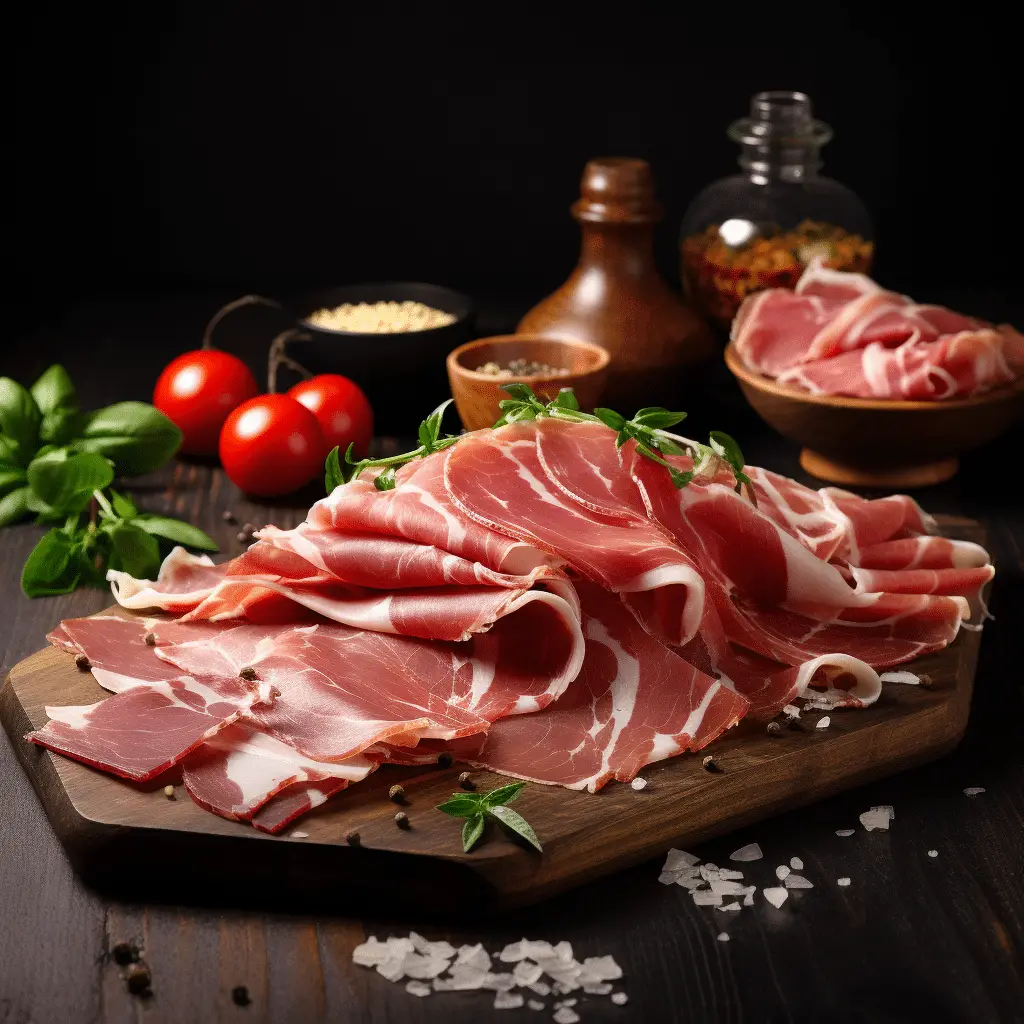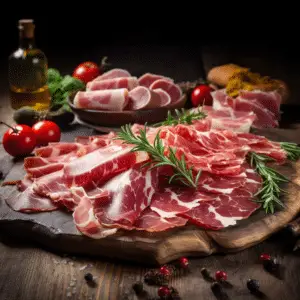
Prosciutto Unveiled: From Curing to Enjoying Raw Delight
Prosciutto Preparation and Consumption: Raw vs. Cooked may seem unachievably fancy, but it’s just traditional Italian meat that found its way to the US. This cured meat is mostly found in specialty imported food shops, cheese shops, grocery stores, some restaurants, or as an ingredient in some foods. So, if you’re gray on this paper-thin slice of heaven, hang in here to know about it.
Aged prosciutto originated from Parma and is produced across Italy. There are many types of prosciutto as people who produce it. This results in different preparation methods, meals, and appetite. There are also many different ways of enjoying prosciutto. But can you eat them uncooked? Or does prosciutto need to be cooked before it can be eaten? Read on!

Does Prosciutto Need To Be Cooked?
No, prosciutto does not need to be cooked if it is dry-cured or prepared, similarly to Parma ham. Dry-cured prosciutto is called Crudo. On the other hand, there’s another type of prosciutto that’s smoked and cooked called Cotto.
Prosciutto crude is not essentially raw but preserved by self-curing and then dried; hence, the name dry-cured. It’s just like dry-cured pancetta or dry-cured salami, which are all eaten raw. Here’s more about why prosciutto can be eaten raw and does not need to be cooked.
Ingredients Used
Many parts of the world have tried to make prosciutto. However, the prosciutto we’re taking here is made in Italy. Italian prosciutto is mainly made with salt and pork and does not involve using high temperatures. However, some people often add nitrates or nitrites to enhance prosciutto’s color, which is acceptable as long as no high temperatures are used.
Generally, ingredients commonly used to make prosciutto are quality pork leg, salt, penicillin, time, favorable environment for drying, skill, and passion. There’s a good balance when curing the meat that helps build up the natural penicillin floating worldwide. Penicillin is the white stuff found on dry-cured salami and what protects meats.
Once penicillin is established as a prosciutto firm, it will be protected and grown in the meat to help in long-term development. Most big firms in Italy, including Parma, still hand salt their prosciutto and produce around 85 000 prosciutto ham per year.
How Does The Salt Cures Prosciutto?
In simple terms, salt inhibits and draws out moisture from the meat. This inhibits or slows down the growth of harmful bacteria inside the meat. It also binds the ins cells inside the meat.
Since ancient times, salt has been used to draw out moisture from foods, preserving it. But the whole technique of salting became fancier with prosciutto. The penicillin protects the outside of the meat while the salt works its magic on the meat’s inside. This produced one of the finest food delicacies in the world.
What’s The Best Way To Eat Prosciutto
If you want to eat prosciutto as they do in a classic Italian style, just put prosciutto in a bun or a few bits of bread, and there you have your prosciutto sandwich. Although this sounds simple, it’s often lined with Italian food.
But if you use good products, your dry-cured charcuterie ham can be a joy to eat. Wrapping prosciutto around melon or rockmelon is one of the best ways to eat it. If you don’t have these two fruits, honeydew and tomato will work just as well. The sweet melons, salty prosciutto, and delicious fat from the prosciutto combine to make tastes that are out of this world. Another good way to enjoy this treat is to eat prosciutto with cheese. Prosciutto and fresh mozzarella cheese go well together, making for a delicious taste.
You can as well cook the prosciutto if you fancy it that way. Doing so will give you crisp meat more like fried bacon, however, note that cooking intensifies the saltiness of the meat and may make it unpleasant for some people. To help reduce the saltiness, don’t cut the prosciutto thick; very thin slices will do. But if doing so still doesn’t work for you, avoid cooking and consume it raw.
When consuming raw, remember to take it along with the fat. The fat help balance the saltiness of the meat, resulting in an overall delicious flavor.
Can You Substitute Prosciutto For Ham?
Yes, you can use prosciutto in recipes that call for ham. Feel free to use prosciutto in many dishes requiring ham like pizza, pasta, omelets, etc. You can also substitute bacon and pancetta with prosciutto.
Can You Warm Up Prosciutto?
You can warm up your prosciutto if you don’t fancy cold foods. When warming, use traditional ways or your preferred way of reheating. You can opt to warm up the prosciutto in an oven at 350 degrees Fahrenheit for a couple of minutes.
Alternatively, pop the prosciutto in a microwave with a paper towel and let it stay there for thirty seconds. It’s advisable to place a bowl over the meat as the grease may splatter, messing with your microwave.
Lastly, you can just pan fry the prosciutto. This works well, especially if you’re planning on eating it with eggs or using it as part of an omelet.
How Should You Store Prosciutto?
Prosciutto can be stored on the shelf if it’s still unopened in its package. Once opened, it should be stored in the fridge. The meat is cured and vacuum sealed; hence it’s safe as long as it’s in its original packaging. Opening the package lets oxygen in, enabling the growth of micro-organisms.
When refrigerating, close the package as tightly as possible. Also, don’t store it for long in the fridge. Doing so will dry out the meat, making it have an unpleasant taste.
Freezing is also an option if you plan on having it a while longer. Frozen prosciutto can last 1-2 months. Remember, the meat will lose its texture when thawing. And unless you plan on frying and getting it crispy once thawed, don’t freeze.

Conclusion
Prosciutto Preparation and Consumption: Raw vs. Cooked does not need to be cooked. This delicacy comes already cured and can be eaten as it is. The curing process for months or years removes all the moisture from the meat, making prosciutto safe to eat. It also removes any harmful bacteria that might be present in the meat.